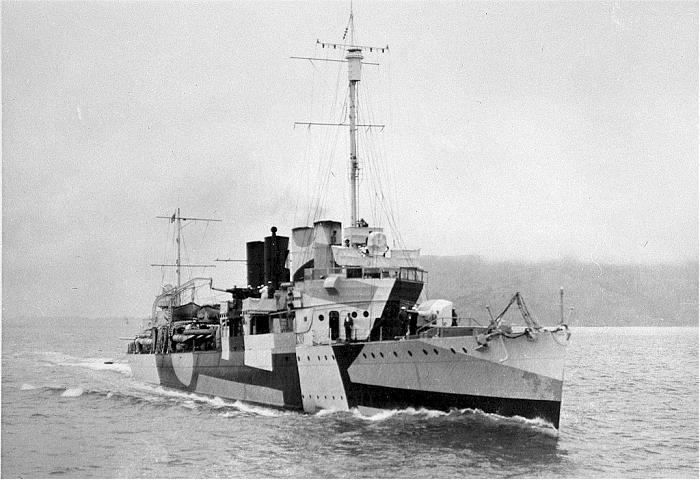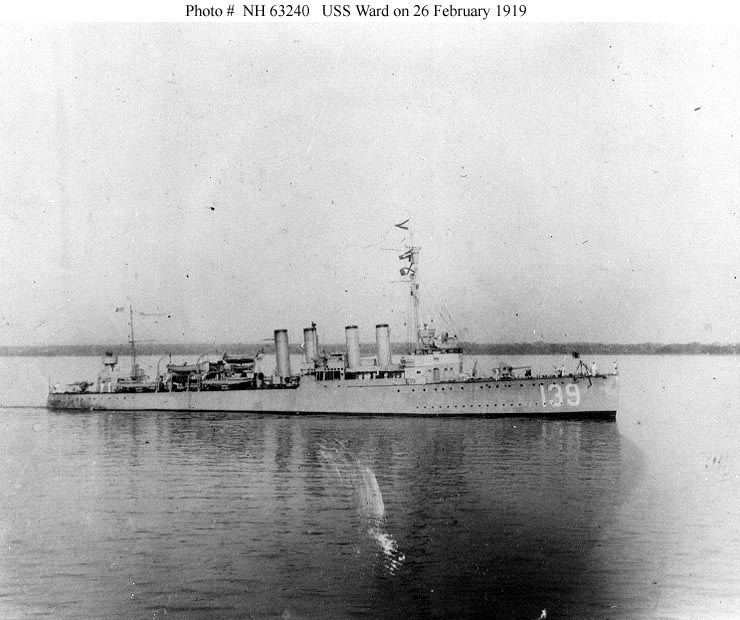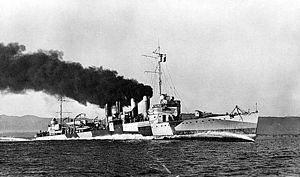Name Ward Laid down 15 May 1918 Decommissioned 21 July 1921 Construction started 15 May 1918 Length 96 m | Namesake James H. Ward Commissioned 24 July 1918 Recommissioned 15 January 1941 Launched 1 June 1918 Beam 9.42 m | |
 | ||
Builder Mare Island Naval Shipyard | ||
USS Ward (DD-139) was a 1,247 long tons (1,267 t) Wickes-class destroyer in the United States Navy during World War I, later APD-16 (see High speed transport) in World War II. She fired the first American shot in World War II, when she engaged the Japanese before the attack on Pearl Harbor, and successfully sank her opponent.
Contents
Design and construction

Ward was named in honor of Commander James Harmon Ward, USN, (1806–1861), the first U.S. Navy officer to be killed in action during the American Civil War. Ward was built at the Mare Island Navy Yard, California in a record of 17½ days. Under the pressure of urgent World War I needs for destroyers, her construction was pushed rapidly from keel-laying on 15 May 1918 to launching on 1 June and commissioning on 24 July 1918.
Service history

Ward transferred to the Atlantic late in the year and helped support the trans-Atlantic flight of the NC flying boats in May 1919. She came back to the Pacific a few months later and remained there until she was decommissioned in July 1921. She had received the hull number DD-139 in July 1920. The outbreak of World War II in Europe brought Ward back into active service. She recommissioned in January 1941. Sent to Pearl Harbor shortly thereafter, the destroyer operated on local patrol duties in Hawaiian waters over the next year.
Pearl Harbor
On the morning of 7 December 1941, under the command of LCDR William W. Outerbridge, Ward was conducting a precautionary patrol off the entrance to Pearl Harbor when she was informed at 03:57 by visual signals from the coastal minesweeper Condor of a periscope sighting, whereupon Ward began searching for the contact. At about 06:37, she sighted a periscope apparently tailing the cargo ship Antares whereupon she attacked the target. The target sunk was a Japanese Ko-hyoteki-class two-man midget submarine and thus Ward fired the first American shots of World War II a few hours before Japanese carrier aircraft formally opened the conflict with their attack on the Pacific Fleet inside the harbor. The submarine was attempting to enter the harbor by following Antares through the anti-submarine nets at the harbor entrance. Ward fired several rounds from its main guns hitting the conning tower of the sub and also dropped several depth charges during the attack.
A minority of academics doubted whether Ward had really sunk a Japanese mini-sub until University of Hawaii scientists found the vessel on 28 August 2002. It lies 1,200 ft (370 m) beneath the sea in American waters about 3–4 mi (2.6–3.5 nmi; 4.8–6.4 km) outside Pearl Harbor. The starboard side of the submarine's conning tower exhibits one shell hole, evidence of damage from Ward's #3 gun. While her depth charges were sufficient to fully lift the 46 long tons (47 t), 78 ft (24 m) submarine out of the water, they did no apparent structural damage to the submarine, which sank due to water flooding into the vessel from the two shell holes.
After Pearl Harbor

In 1942, Ward was sent to the West Coast for conversion to a high-speed transport. Redesignated APD-16 in February 1943, she steamed to the South Pacific to operate in the Solomon Islands area. She helped fight off a heavy Japanese air attack off Tulagi on 7 April 1943 and spent most of the rest of that year on escort and transport service. In December, she participated in the Cape Gloucester invasion. During the first nine months of 1944, Ward continued her escort and patrol work and also took part in several Southwest Pacific amphibious landings, among them the assaults on Saidor, Nissan Island, Emirau, Aitape, Biak, Cape Sansapor and Morotai.
Fate
As the Pacific War moved closer to Japan, Ward was assigned to assist with operations to recover the Philippine Islands. On 17 October 1944, she put troops ashore on Dinagat Island during the opening phase of the Leyte invasion. After spending the rest of October and November escorting ships to and from Leyte, in early December Ward transported Army personnel during the landings at Ormoc Bay, Leyte. On the morning of 7 December, three years to the day after her No. 1 gun fired the opening shot of America's involvement in the war, she was patrolling off the invasion area when she came under attack by several Japanese kamikazes. One bomber hit her hull amidships, bringing her to a dead stop. When the resulting fires could not be controlled, Ward's crew was ordered to abandon ship, and she was sunk by gunfire from O'Brien, whose commanding officer, William W. Outerbridge, had been in command of Ward during her action off Pearl Harbor three years before.
In the movie Tora! Tora! Tora!, Ward was portrayed by USS Finch (DE-328).
Memorial
Ward's No. 3 4 in (100 mm)/50 cal gun was removed when she was converted to a high speed transport. It was installed in 1958, the year of the Minnesota Centennial, as a memorial at the Minnesota State Capitol in St. Paul, as the men who fired it on 7 December 1941 were members of the Minnesota Naval Reserve. A plaque containing a listing of the Naval Reservists from Saint Paul who served aboard Ward is now displayed in the St. Paul City Hall on the 3rd floor between the council and mayoral offices, in an area also containing the ship's bell from the cruiser Saint Paul. The last surviving member of the gun crew from the morning of 7 December, Alan Sanford, died in January 2015.
As of 2012, no other ship in the United States Navy has borne this name, although there is sometimes confusion with the three destroyers named Aaron Ward.
